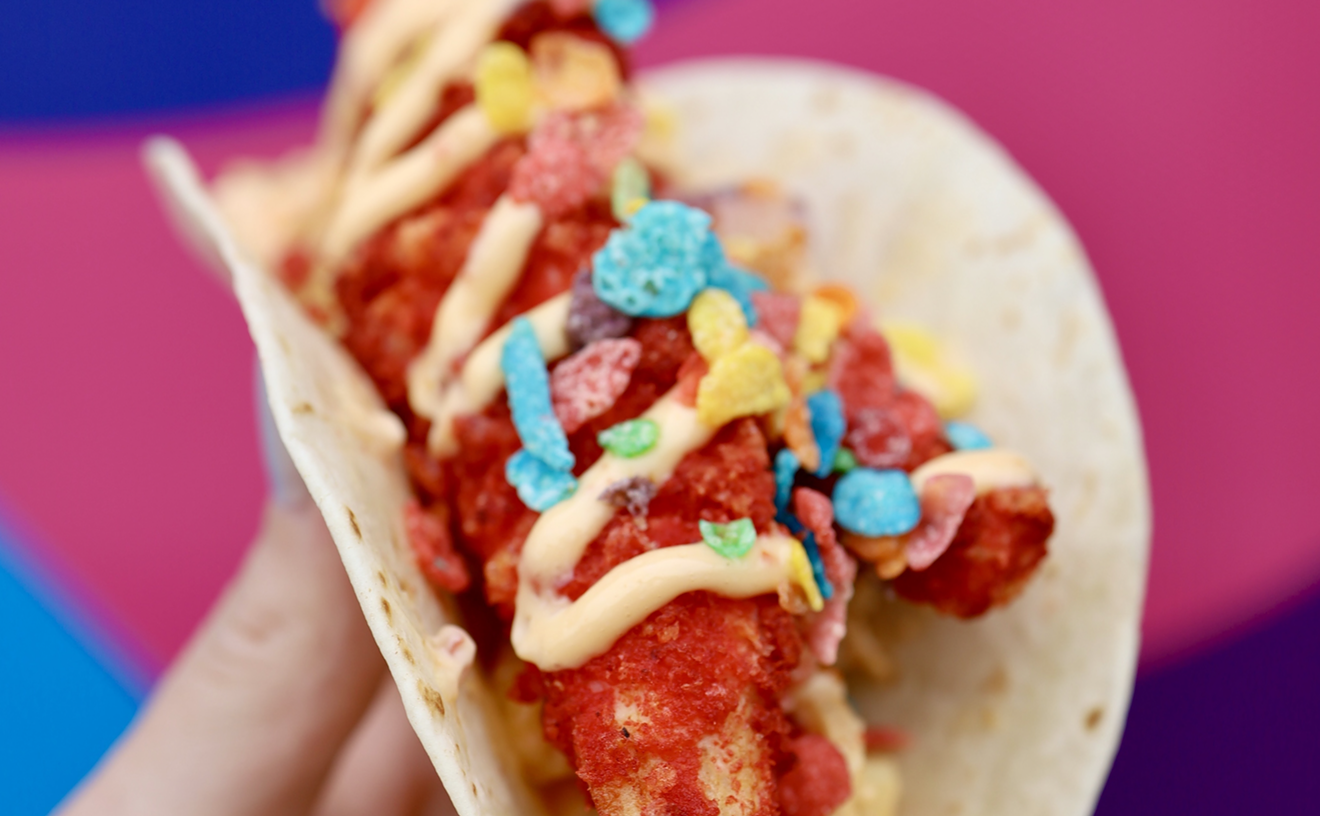We started with a terrific tuna tartare, diced and punctuated with pineapple, scallions, and ripe avocado, and then heaped onto a banana leaf in a giant clam shell atop a large dish of ice -- presentations here are fetchingly innovative. Accompanying plantain chips were crisp enough to scoop up the tartare, passion fruit dressing spiked with wasabi and flecks of pungent black pepper adding just the right dose of sweet and heat. Portions at Suva are served family style, and the waitstaff politely encourages diners to share. The waitresses, incidentally, were dressed brightly in floral-patterned South Seas-style sarongs. So were the waiters, but the staff was so friendly, unpretentious, and competent that I couldn't bring myself to smirk.
The tartare easily can feed two; an appetizer of roast pork ropa vieja is double the average size, maybe a pound's worth of softly shredded pork piled on one side of a silver oval platter that is elevated like a cake stand. Beside the pork came a pineapple-jicama-coconut sambal (Indonesian for relish) and piquant peanut sauce. Finally there was a mound of iceberg lettuce cups in which to roll it all together -- not just fun to eat but an exquisite mix of tastes. "Down Island spiced chicken skewers" were a good deal less impressive, six squares of chicken breast grilled on sugar-cane spears with a too-thinly applied guava barbecue glaze -- not bad, but unremarkable. The best part of the dish was the refreshing slaw of minted green mango.
The incessantly clement weather makes it difficult to fathom that it's still winter, but it is, and a main course of grilled mahi-mahi atop a hearty hash of roasted blue potato and heart of palm was so comforting it made me yearn to sit in front of a glowing hearth. The roasted slices of palm offered an unexpected chestnut texture, which with the potato provided a unique nutty-starchy accompaniment; roasted asparagus was served as the complementing green. The fish was no less impressive than its partners, long succulent flakes enlivened by a fiery passion fruit and ancho mole glaze.
Fijian fisherman's stew arrived in a green coconut shell overflowing with three giant, juicy, just-cooked scallops; two plump prawns; multiple mussels and calamari rings; and one lonely lobster nugget, all bound by a sweet, creamy, and spicily curried coconut sauce. Surrounding the coconut were couscous with toasted strands of coconut and a stack of moist johnnycakes (pancakes, usually drier and more brittle than these, made with flint cornmeal). It could have provided a generous dinner for two, as would any main course on the menu, which in effect turns a pricey $28 entrée into a relative bargain. Not only can you share food but also company, at one of two long rectangular communal tables.
I had anticipated that the cuisine here would be laced with too much fruity sweetness, but that fear was unfounded. Salt, too, is metered out judiciously (except for soon-to-be-mentioned exceptions), and ubiquitous garlic is never the dominant taste. The food's vibrant freshness shines though a surge of hot spices and cool fruits that practically trip over one another as they tumble across the palate. But they never do trip: An equilibrium of flavors is at all times maintained. Well, almost all times. Fried snapper was well-balanced conceptually but not in execution. The whole fish, which was scrumptious, came boned and stuffed with creamed coconut spinach chock full of tender lobster chunks. On one end of the platter were pickled fruits and vegetables (pickled star fruit in particular was smashing, and something I'd never had before). On the other end, though, a dark, crumbly, greasy thatch of inedibly salty fried spinach, and likewise oversalted chips that together tipped the balance scale as quickly as a fat person on a seesaw. Even when fried spinach comes as clean green crystalline crisps, like in China Grill's signature side dish, I find that it turns tiresome after the first few scintillating bites.
Suva sails along smoothly, particularly for a restaurant less than two months old, though there were a couple of minor bumps along the way. Certainly we could have done without the thump-thump-thumping of dance music, which was a tad loud and thematically inappropriate as a backdrop to South Pacific cuisine. Come to think of it, the soundtrack to South Pacific would have been perfect. And it isn't far-fetched to imagine that the chairs here, with rock-hard bamboo rods acting as the cushion, once were used to torturously extract information from Malaysian prisoners.
The spirit of sharing extends to dessert, unless you're still hungry enough to gluttonously indulge in seven small but rich slices of creamy banana chocolate bread pudding by yourself. That would include chocolate Myers's rum crme anglaise, dulce de leche ice cream, and two plantain crisps dusted with sugar and squirted with chocolate syrup. Most popular coda seemed to be the Bora Bora banana split, with roasted banana and pineapple, guanabana ice cream, and two sauces: chocolate rum and passion fruit caramel. We probably should have gone with that one instead of the Fiji "tropical" fruit plate with chocolate rum fondue. I used to live across the street from a chocolatier that sold lemon slices dipped in white chocolate; they sounded questionable but were delicious, which taught me to never prejudge a chocolate-dipped fruit before trying it. The Fiji plate afforded me the opportunity to taste firsthand which fruits do not go well with chocolate. For instance when it comes to dipping honeydew, I now have the know-how to unequivocally declare: "Honey, don't." Ditto for watermelon. Star fruit and pineapple match up a little better, but the only things on the plate that made any sense were strawberries, macaroons, and marshmallow squares. They might consider adding bananas, coconut, and tangerine in place of the less-appropriate fruits. There was again ample quantity, but just the same this had to be the most disappointing $12.50 dessert I can recall sampling.
Some 80 wines are whimsically divvied up into categories such as "bold & rich," "fiery & racy," and "robust & lavish," which make apt adjectives for the cuisine as well; I'd only add "honest" and "bursting with clever flavors." In fact I enjoyed the dining experience at Suva so much that I offer not one but three accolades suitable for use in print ads: (1) The best China Grill Management property since Tuscan Steak. (2) The best expensive restaurant to open on (or just off) Lincoln Road since Pacific Time. (3) The best thing co-owner Marisa Tomei has played a part in since My Cousin Vinny.











